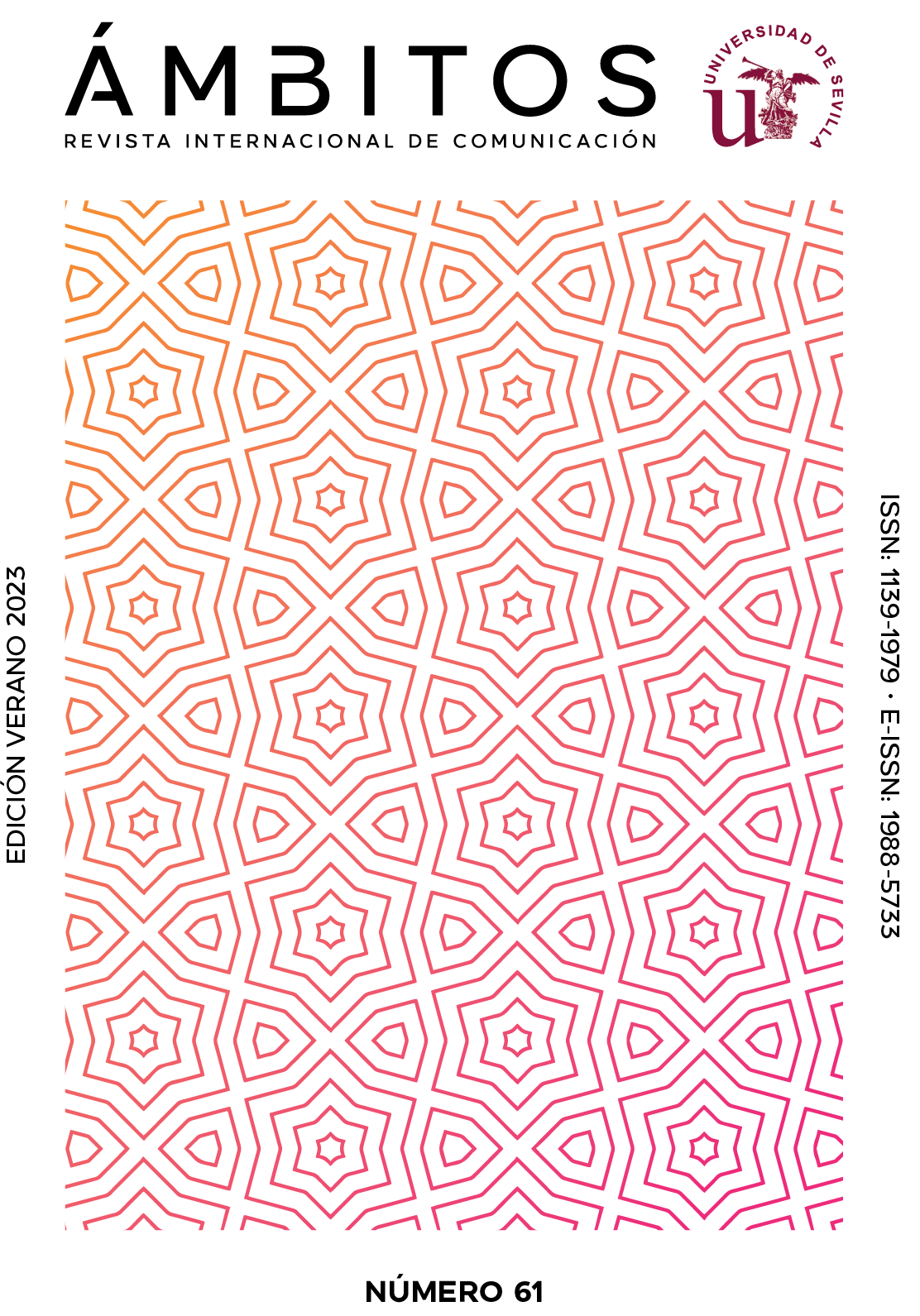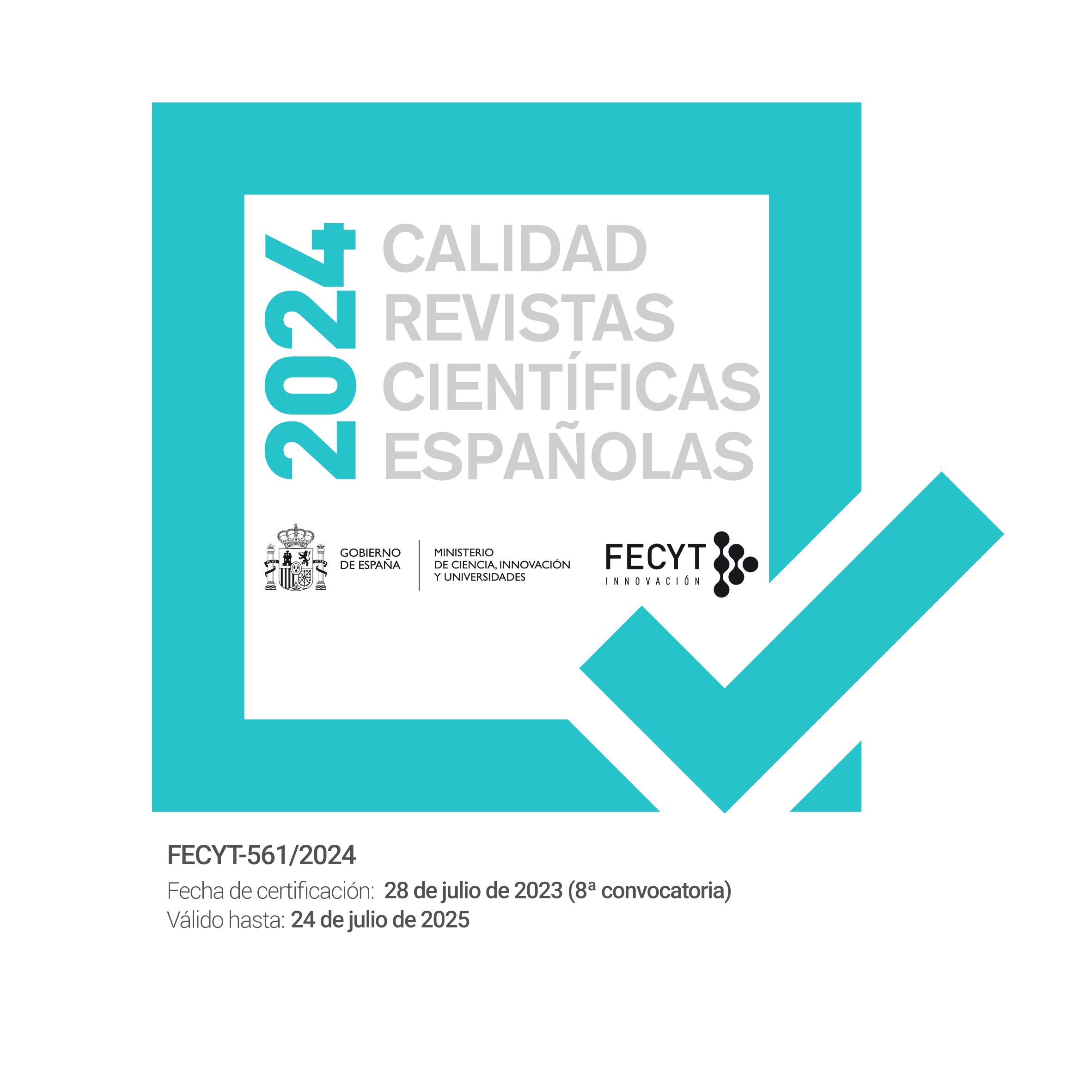The character arc through clothing and accessories in the Queen's Gambit miniseries
DOI:
https://doi.org/10.12795/Ambitos.2023.i61.05Keywords:
Queen's gambit, miniseries, character arc, fashion and chessAbstract
The character arc reflects how a character evolves internally throughout a story. At the same time, the character's clothing and accessories –make‑up and hairstyle– also express her interiority, in a creative way. This research work has found out what relationship exists between the character arc, the costumes and the accessories of Beth Harmon, main character of the miniseries Queen's gambit. It is one of the most watched series in the history of Netflix´s platform, and set a trend in Western fashion. To achieve the proposed objective, a content analysis of the seven chapters of the miniseries has been carried out, and fourteen scenes have been selected that correspond to key moments in the plot, in order to analyze the clothing and accessories of the protagonist, to find out if these reflect her character arc. For the establishment of the categories, authors who identify the meaning of the colors and shapes in clothing, as well as the type of accessories, have been followed. The results show that the protagonist's outfits reveal an inner change in her, which goes from negative attitudes based on addictions and frustrations, to positive attitudes of overcoming and maturity.
Downloads
References
Atarama‑Rojas, T., Castañeda‑Purizaga, L., & Agapito‑Mesta, C. (2017). Los arquetipos como herramientas para la construcción de historias: Análisis del mundo diegético de “Intensamente”. Ámbitos. Revista Internacional de Comunicación, (36), 1–15. https://n9.cl/rdw4q
Avendaño, T. C. (23 de noviembre de 2020). ‘Gambito de dama’ es la miniserie más vista de Netflix, con reproducciones en 62 millones de hogares. El País. https://bit.ly/3wN3riy
Avendaño, L., & Hernández, M. (2010). La dirección de arte cinematográfica y televisiva en Colombia: un primer campo exploratorio [Tesis de licenciatura, Pontificia Universidad Javeriana]. https://n9.cl/ps6pl
Brenes, C. (2012). Buenos y malos personajes. Una diferencia poética antes que ética. Revista de Comunicación, (11), 7–23. https://cutt.ly/qwqCCTRJ
Calderón Bilbao, M. (2009). El diseño de vestuario en cine. Superficie textil y paleta cromática del diseño de vestuario en relación a la fotografía cinematográfica [Tesis de licenciatura, Universidad de Chile]. https://cutt.ly/2wqCCJkd
Caman Molero, K., & Atarama Rojas, T. (2015). Aportes del derecho de la comunicación a la ficción audiovisual: Análisis del constitutivo esencial del mensaje cinematográfico a partir de la valoración del universo diegético de Toy Story. Derecom, (19), 183–203. https://bit.ly/3NCP20S
Fernández, D., & Jácome, D. (2018). Vestir al personaje vestuario escénico: de la historia a la ficción dramática (1° ed.). Cumbres.
Field, S. (1995). El Manual del guionista. Dell Publishing.
Frank, S., Horberg, W. & Scott, A. (Productores ejecutivos). (2020). Gambito de dama [Serie de Televisión]. Flitcraft; Wonderful films.
Heller, E. (2008). Psicología del color. Editorial Gustavo Gili.
Hobbs, J. (2020). Gambito de Dama: Su diseñadora de vestuario revela el significado tras el estilo de Beth Harmon. Vogue. https://cutt.ly/1wqCC077
Kohl School. (9 de diciembre de 2020). Las claves del vestuario de Gambito de Dama. https://bit.ly/3WDEVxj
Konigsberg, I. (2004). Diccionario técnico Akal de Cine. Ediciones Akal.
López, A. (2015). La evolución de la dirección de arte en el desarrollo de la acción dramática: El caso de Edward Manos de tijeras, Mujeres al borde de un ataque de nervios y Oldboy [Tesis de Licenciatura, Pontificia Universidad Católica del Perú]. https://n9.cl/3c1wd
López, M., & Nicolás, M. (2015). El análisis de series de televisión: Construcción de un modelo interdisciplinario. Revista ComHumanitas, 6(1), 22–39. https://bit.ly/45PiMQW
Luca, L., & Mercado, G. (2019). Vestuario: Entre el cine y la moda. Cuadernos del Centro de Estudios de Diseño y Comunicación, (57), 39–45. https://doi.org/10.18682/cdc.vi57.1359
Mascio, A. (2019). La moda como forma de valorización de las series de televisión. Cuadernos del Centro de Estudios de Diseño y Comunicación, (44), 185–195. https://doi.org/10.18682/cdc.v44i44.1594
Mathews, P. (2018). It must be love: an exploration of the character arc model in screenwriting practice and theory. [Tesis de doctorado, Bournemouth University]. https://n9.cl/l3huu
Ortiz, C. (2013). El vestuario en el cine. Más allá de la prenda [Tesis de doctorado, Universidad Pontificia Bolivariana] https://bit.ly/3qhoUB0
Peña, P. (2020). La verdadera jugada maestra de «Gambito de dama» es su vestuario: guiños al tablero de ajedrez, homenajes a Courrèges y referencias a Prada. Vanity Fair. https://bit.ly/45GdNSC
Pérez‑Rufí, J., & Pérez‑Rufí, M. (2018). La función narrativa del vestuario en el cine: la apariencia física del personaje cinematográfico como elemento de caracterización en el cine clásico de Hollywood. Razón y palabra, 22(101), 547‑568. https://bit.ly/3BZWKx8
Personalitia (18 de junio de 2015). ¿Qué significa cada estampado? https://bit.ly/3WEOgos
Sánchez‑Escalonilla, A. (2001). Estrategias de guion cinematográfico. Ariel Cine.
Sánchez‑Escalonilla, A. (2013). Verisimilitude and film story: The links between screenwriter, character and spectator. Communicatio Socialis, 26(2), 79–94. https://n9.cl/uui53
Seger, L. (1991). Cómo convertir un buen guion en un guion excelente. Rialp.
Smith, G. M. (2006). A case of cold feet: Serial narration and the character arc. Journal of British Cinema and Television, 3(1), 82–94. https://doi.org/10.3366/JBCTV.2006.3.1.82
Sulbarán, E. (2000). El análisis del film: Entre la semiótica del relato y la narrativa fílmica. Opción: Revista de Ciencias Humanas y Sociales, (31), 44–71.
Tatler (30 de noviembre de 2020). How Netflix’s “The Queen’s Gambit” influences our fashion. https://bit.ly/3C0TlhB
Timón, R., & García, V. (2016). La máscara cosmética en el cine de John Waters: Análisis narrativo de los personajes protagonistas de Pink Flamingos y Female Trouble. Creatividad y Sociedad, (25), 144–169. https://bit.ly/3ORZnJ7
Tinto Arandes, J. (2013). El análisis de contenido como herramienta de utilidad para la realización de una investigación descriptiva. Un ejemplo de aplicación práctica utilizado para conocer las investigaciones realizadas sobre la imagen de marca de España y el efecto país de origen. Provincia, (29), 135–173. https://bit.ly/3ovyFeB
Downloads
Published
How to Cite
Issue
Section
License
Copyright (c) 2023 Enrique García Romero, Elia Solís Paredes, Natalí Agapito Mesta, Noelia Sánchez Tineo

This work is licensed under a Creative Commons Attribution-NonCommercial-ShareAlike 4.0 International License.
Ámbitos. Revista Internacional de Comunicación is an open access journal, which means that all content is freely available at no charge to the user or their institution. Users may read, download, copy, distribute, distribute, print, search or link to the full text of articles, or use them for any other lawful purpose, without seeking prior permission from the publisher or author. This definition of open access is in accordance with the Budapest Open Access Initiative (BOAI).

Unless otherwise noted, all content in the electronic edition is distributed under a "Creative Commons Attribution-NonCommercial-ShareAlike 4.0 International License". You can consult the informative version and legal text of the licence here. This should be expressly stated in this way where necessary.
In case of acceptance of the manuscript, the authors cede the rights of the work for its publication to Ámbitos. Revista Internacional de Comunicación under the Attribution-NonCommercial-ShareAlike 4.0 International license contract (CC BY-NC-SA 4.0). The authors retain copyright and third parties are authorised to copy, distribute and make use of the work, provided they comply with the terms and conditions set out in the licence
- Cite the authorship and the original source of publication (journal, publisher and URL of the work).
- Do not use them for commercial purposes.
- If you remix, transform or create from the material, you must release your contributions under the same license as the original.
More information can be found at https://creativecommons.org/licenses/by-nc-sa/4.0/deed.es


















